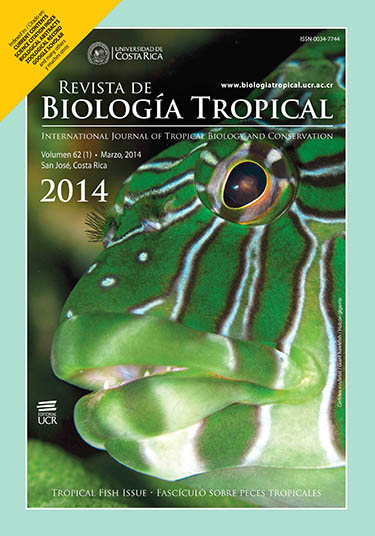Abstract
Coastal lagoons are considered important nursery areas for many coastal fishes. Barra de Navidad coastal lagoon (3.76km2) is important for local economy as it supports tourism development and artisanal fisheries. However, the role of this lagoon in the dynamics of coastal fish populations is scarcely known. Thus, the objectives of this research were: to characterize the water of the lagoon and related weather conditions, to develop a systematic list of the ichthyofauna, and to estimate the proportion of juveniles in the total number of individuals captured of most abundant species. Water and fish samples were collected between March 2011 and February 2012. Physical and chemical variables were measured in rainy and dry seasons. Several fishing gears were used including a cast net, beach purse seine and gillnets of four different mesh sizes. Our results showed that the lagoon is most of the time euhaline (salinity 30-40ups), although it can be mixopolyhaline (salinity 18-30ups) during short periods. Chlorophyll and nutrients concentrations suggested eutrophication in the lagoon. Mean water temperature changed seasonally from 24.9°C (April, high tide) to 31.4°C (October, low tide). Considering ichthyofauna species, a total of 36 448 individuals of 92 species were collected, 31 of them adding up to 95% of the total of individuals caught. Dominant species were Anchoa spp. (44.6%), Diapterus peruvianus (10.5%), Eucinostomus currani (8.1%), Cetengraulis mysticetus (7.8%), Mugil curema (5.2%) and Opisthonema libertate (4.5%). The lagoon is an important juvenile habitat for 22 of the 31 most abundant species. These included several species of commercial importance such as snappers (Lutjanus argentiventris, L. colorado and L. novemfasciatus), snook (Centropomus nigrescens) and white mullet (Mugil curema). Other four species seem to use the lagoon mainly as adults. This paper is the first contribution on the composition of estuarine ichthyofauna in Jalisco State, and it also constitutes the more complete reference on the detailed size composition of a set of dominant species in a coastal lagoon in the central Mexican Pacific.##plugins.facebook.comentarios##
Downloads
Download data is not yet available.


